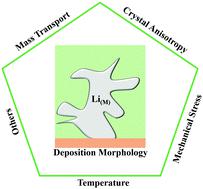当前位置:
X-MOL 学术
›
Chem. Soc. Rev.
›
论文详情
Our official English website, www.x-mol.net, welcomes your
feedback! (Note: you will need to create a separate account there.)
Regulating electrodeposition morphology of lithium: towards commercially relevant secondary Li metal batteries.
Chemical Society Reviews ( IF 40.4 ) Pub Date : 2020-03-31 , DOI: 10.1039/c9cs00883g Jingxu Zheng 1 , Mun Sek Kim , Zhengyuan Tu , Snehashis Choudhury , Tian Tang , Lynden A Archer
Chemical Society Reviews ( IF 40.4 ) Pub Date : 2020-03-31 , DOI: 10.1039/c9cs00883g Jingxu Zheng 1 , Mun Sek Kim , Zhengyuan Tu , Snehashis Choudhury , Tian Tang , Lynden A Archer
Affiliation

|
Lithium, the lightest and most electronegative metallic element, has long been considered the ultimate choice as a battery anode for mobile, as well as in some stationary applications. The high electronegativity of Li is, however, a double-edged sword-it facilitates a large operating voltage when paired with essentially any cathode, promising a high cell-level energy density. It is also synonymous with a high chemical reactivity and low reduction potential. The interfaces a Li metal anode forms with any other material (liquid or solid) in an electrochemical cell are therefore always mediated by one or more products of its chemical or electrochemical reactions with that material. The physical, crystallographic, mechanical, electrochemical, and transport properties of the resultant new material phases (interphases) regulate all interfacial processes at a Li metal anode, including electrodeposition during battery recharge. This Review takes recent efforts aimed at manipulating the structure, composition, and physical properties of the solid electrolyte interphase (SEI) formed on an Li anode as a point of departure to discuss the structural, electrokinetic, and electrochemical requirements for achieving high anode reversibility. An important conclusion is that while recent reports showing significant advances in the achievement of highly reversible Li anodes, e.g. as measured by the coulombic efficiency (CE), raise prospects for as significant progress towards commercially relevant Li metal batteries, the plateauing of achievable CE values to around 99 ± 0.5% apparent from a comprehensive analysis of the literature is problematic because CE values of at least 99.7%, and preferably >99.9% are required for Li metal cells to live up to the potential for higher energy density batteries offered by the Li metal anode. On this basis, we discuss promising approaches for creating purpose-built interphases on Li, as well as for fabricating advanced Li electrode architectures for regulating Li electrodeposition morphology and crystallinity. Considering the large number of physical and chemical factors involved in achieving fine control of Li electrodeposition, we believe that achievement of the remaining ∼0.5% in anode reversibility will require fresh approaches, perhaps borrowed from other fields. We offer perspectives on both current and new strategies for achieving such Li anodes with the specific aim of engaging established contributors and newcomers to the field in the search for scalable solutions.
中文翻译:

调节锂的电沉积形态:面向商业相关的二次锂金属电池。
锂,最轻和最具负电性的金属元素,长期以来一直被认为是移动和某些固定应用中电池阳极的最终选择。Li的高电负性是一把双刃剑,当与基本上任何阴极配对时,它都能促进较大的工作电压,从而保证了较高的电池级能量密度。它也是高化学反应性和低还原电位的同义词。因此,锂金属阳极与电化学电池中任何其他材料(液体或固体)形成的界面始终由其与该材料的化学或电化学反应的一种或多种产物介导。物理,晶体学,机械,电化学,所得新材料相(相间)的输运性能调节锂金属阳极上的所有界面过程,包括电池充电期间的电沉积。这篇综述采取了近期的努力,旨在操纵在Li阳极上形成的固体电解质中间相(SEI)的结构,组成和物理特性,以此作为出发点来讨论实现高阳极可逆性的结构,电动和电化学要求。一个重要的结论是,尽管最近的报告显示出高度可逆的锂阳极取得了重大进展,例如通过库仑效率(CE)进行的测量,却为商业上可观的锂金属电池取得了重大进展,但可实现的CE值却趋于平稳。到大约99±0。从文献的全面分析来看,有5%的问题是有问题的,因为要使锂金属电池发挥出由锂金属阳极提供的更高能量密度电池的潜力,至少需要CE值至少为99.7%,优选> 99.9%。在此基础上,我们讨论了在Li上创建专用相的有前途的方法,以及制造用于调节Li电沉积形态和结晶度的高级Li电极体系结构的方法。考虑到实现锂电沉积精细控制所涉及的大量物理和化学因素,我们认为要实现阳极可逆性中剩余的约0.5%,将需要新的方法,也许是从其他领域借来的。
更新日期:2020-03-31
中文翻译:

调节锂的电沉积形态:面向商业相关的二次锂金属电池。
锂,最轻和最具负电性的金属元素,长期以来一直被认为是移动和某些固定应用中电池阳极的最终选择。Li的高电负性是一把双刃剑,当与基本上任何阴极配对时,它都能促进较大的工作电压,从而保证了较高的电池级能量密度。它也是高化学反应性和低还原电位的同义词。因此,锂金属阳极与电化学电池中任何其他材料(液体或固体)形成的界面始终由其与该材料的化学或电化学反应的一种或多种产物介导。物理,晶体学,机械,电化学,所得新材料相(相间)的输运性能调节锂金属阳极上的所有界面过程,包括电池充电期间的电沉积。这篇综述采取了近期的努力,旨在操纵在Li阳极上形成的固体电解质中间相(SEI)的结构,组成和物理特性,以此作为出发点来讨论实现高阳极可逆性的结构,电动和电化学要求。一个重要的结论是,尽管最近的报告显示出高度可逆的锂阳极取得了重大进展,例如通过库仑效率(CE)进行的测量,却为商业上可观的锂金属电池取得了重大进展,但可实现的CE值却趋于平稳。到大约99±0。从文献的全面分析来看,有5%的问题是有问题的,因为要使锂金属电池发挥出由锂金属阳极提供的更高能量密度电池的潜力,至少需要CE值至少为99.7%,优选> 99.9%。在此基础上,我们讨论了在Li上创建专用相的有前途的方法,以及制造用于调节Li电沉积形态和结晶度的高级Li电极体系结构的方法。考虑到实现锂电沉积精细控制所涉及的大量物理和化学因素,我们认为要实现阳极可逆性中剩余的约0.5%,将需要新的方法,也许是从其他领域借来的。











































 京公网安备 11010802027423号
京公网安备 11010802027423号